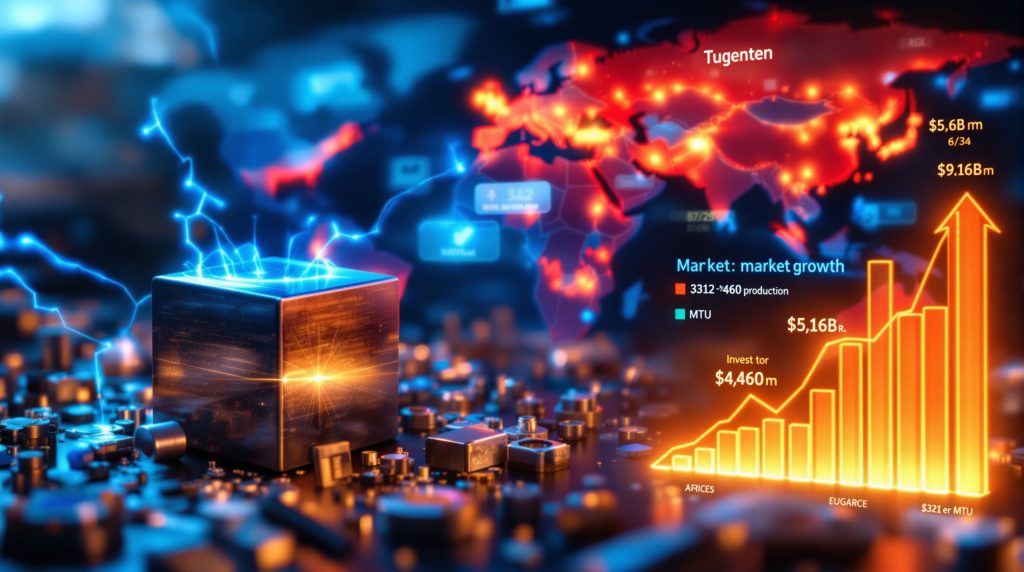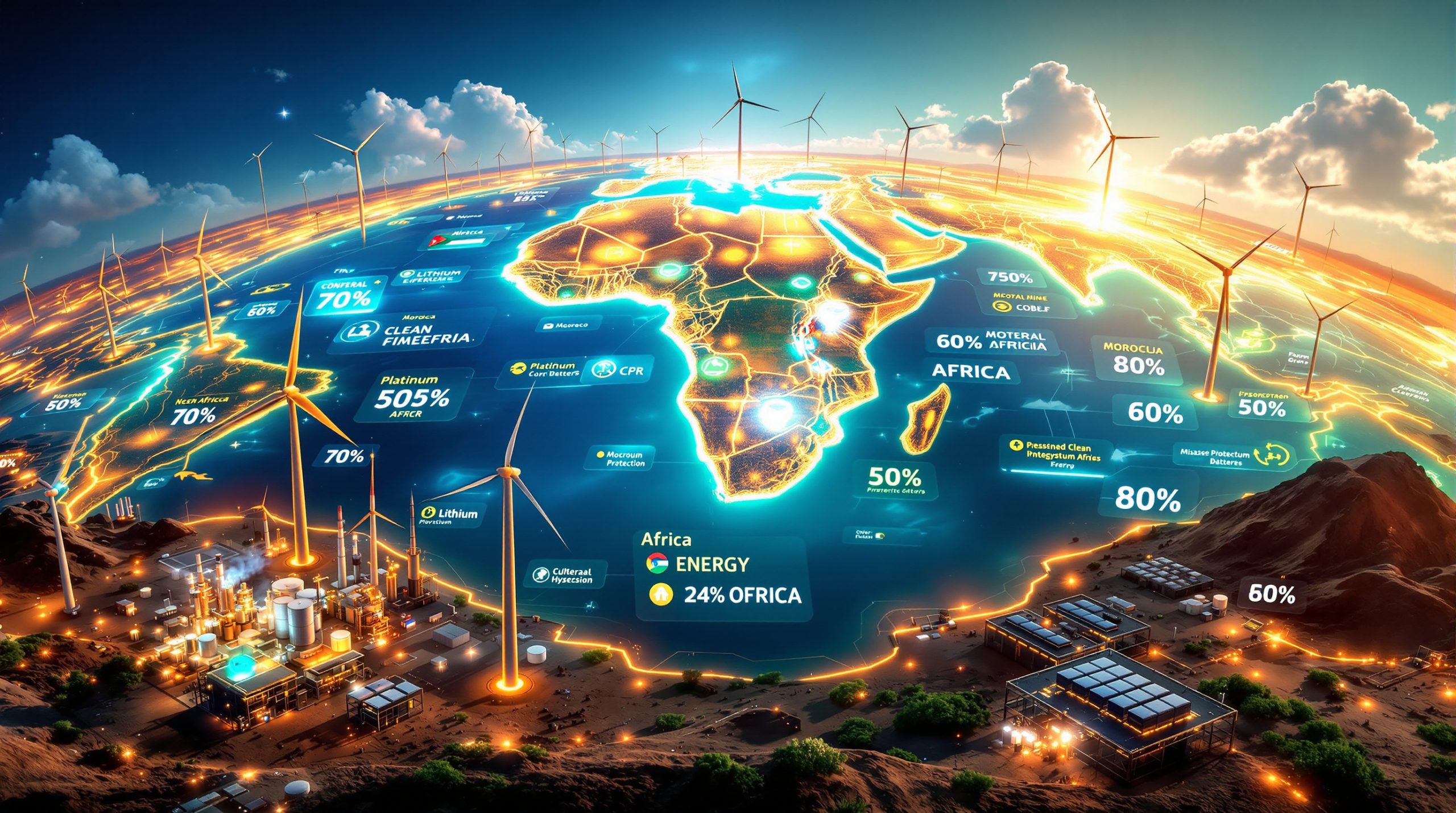Understanding Tungsten's Strategic Importance in Today's Market
Tungsten, often overlooked in mainstream investment discussions, represents a compelling opportunity for forward-thinking investors. Its unparalleled hardness, exceptional heat resistance, and critical applications across multiple high-growth industries have established tungsten as a strategic metal with significant investment potential.
With the highest melting point of all metals (3,422°C), exceptional hardness and density, and remarkable corrosion resistance, tungsten has become indispensable in advanced manufacturing and technology applications. These unique physical properties make it virtually irreplaceable in industries ranging from aerospace and defense to electronics and clean energy.
The metal's incredible durability allows it to withstand extreme conditions where other materials would fail, making it a cornerstone material for high-performance applications. As one mining executive noted during a recent industry conference, "There's simply no viable substitute for tungsten in many critical applications where extreme durability and heat resistance are required."
What Makes Tungsten a Critical Metal?
Beyond its physical properties, tungsten's strategic importance stems from its essential role in multiple industries experiencing rapid growth:
- Aerospace and defense: Used in rocket nozzles, armor-piercing ammunition, and radiation shielding
- Industrial manufacturing: Essential for high-performance cutting tools, dies, and wear-resistant components
- Electronics: Critical in heat sinks, electrical contacts, and integrated circuits
- Automotive: Increasingly important in electric vehicle production and specialized components
- Medical technology: Used in radiation shielding, surgical instruments, and imaging equipment
As industrial technologies advance, tungsten's importance grows proportionally. The metal's unique combination of properties makes it crucial for applications where failure is not an option, including mission-critical defense systems and life-saving medical devices.
Why Is Tungsten Attracting Investment Interest Now?
The tungsten market has entered a significant growth phase, creating compelling tungsten investment opportunities. Market analysis indicates the global tungsten market, valued at approximately $5.16 billion in 2024, is projected to reach $9.65 billion by 2032, representing a compound annual growth rate (CAGR) of 8.1% from 2025-2032.
This growth trajectory significantly outpaces many traditional commodity markets, creating opportunities for early investors to capitalize on tungsten's expanding market footprint. The timing appears particularly favorable, as tungsten remains relatively under-followed compared to metals like copper, lithium, or rare earth elements.
Supply-Demand Dynamics Creating Price Pressure
The tungsten market is experiencing a perfect storm of supply constraints and demand growth:
Supply Challenges:
- China controls 82-84% of global tungsten production according to USGS data
- Tightening export restrictions from Chinese producers since late 2024
- Limited new production coming online outside China
- Environmental regulations limiting expansion of existing operations
- Geopolitical tensions affecting global supply chains
Demand Drivers:
- Accelerating adoption in high-tech manufacturing
- Expanding applications in electric vehicles and renewable energy infrastructure
- Increased defense spending globally following geopolitical tensions
- Growing use in medical equipment and specialized electronics
- Development of new technologies requiring tungsten's unique properties
This imbalance has driven significant price appreciation:
- 2023 average price: $312 per metric ton unit (MTU)
- Early 2025 price: $415 per MTU
- Projected 2026 price: Potentially exceeding $460 per MTU
Industry insiders note that tungsten prices have shown less volatility than many other industrial metals while maintaining steady upward momentum, making it particularly attractive to institutional investors seeking more stable commodity exposure.
What Are the Key Tungsten Investment Vehicles?
For investors looking to gain exposure to the tungsten market, several investment approaches offer varying degrees of direct involvement, risk profiles, and potential returns.
Direct Investment in Tungsten Mining Companies
Investing in publicly traded tungsten producers offers the most direct exposure to tungsten price movements:
Major Producers:
- Almonty Industries (TSXV: AII) – Operating mines in Portugal and South Korea
- Elementos Limited (ASX: ELT) – Developing tungsten projects in Australia
- eMetals Limited (ASX: EMT) – Exploration focus on tungsten deposits
- American Tungsten Corp. (CSE: TUNG) – Developing the IMA Mine in Idaho
Emerging Players:
- Guardian Metals (OTC: GMTLF) – Nevada-based tungsten developer with DoD funding of $6.2 million
- Helix Exploration (OTC: HHEXF) – Montana-based resource developer with tungsten exposure
When evaluating mining companies, investors should consider factors beyond simple tungsten exposure, including:
- Production timeline and development stage
- Resource quality and extraction costs
- Management experience and track record
- Balance sheet strength and funding requirements
- Jurisdictional risk and permitting status
Mining industry veteran John Fenick notes that in the case of Guardian Metals, strategic investors like Stan Druckenmiller (who owns approximately 15% of the company) provide added confidence in the company's potential. Such high-profile investor involvement can signal long-term strategic value.
Investing in Tungsten Recycling Technologies
Recycling represents a growing segment of tungsten supply:
- Currently accounts for approximately 37% of tungsten demand
- Expected to reach 45% by 2030 as new technologies come online
- Recycling processes becoming more efficient and economically viable
- Environmental regulations driving increased recycling rates
Companies developing proprietary tungsten recycling technologies offer potential high-growth opportunities, particularly as global sustainability initiatives intensify. The tungsten recycling market is expected to grow at a CAGR of approximately 5.8% through 2030, according to industry forecasts.
Strategic ETFs and Specialty Metals Funds
While no pure-play tungsten ETFs exist, several specialty metals and strategic resources funds provide partial exposure:
- VanEck Rare Earth/Strategic Metals ETF (REMX)
- Sprott Physical Uranium Trust (U.UN)
- Global X Critical Materials ETF (CMAT)
These funds typically include tungsten as part of a broader basket of strategic metals, providing diversified exposure to the sector while mitigating single-commodity risk. However, investors should note that tungsten typically represents only a small percentage of these funds' holdings.
How Is Government Policy Influencing Tungsten Investment Opportunities?
Government policies worldwide are increasingly recognizing tungsten's strategic importance, creating significant investment catalysts through funding initiatives, regulatory support, and strategic stockpiling programs.
Critical Mineral Designations Driving Support
Tungsten has been designated a critical mineral by multiple governments:
- United States: Listed on the 2022 Critical Minerals List
- European Union: Identified as one of 34 critical raw materials
- Australia: Included in the Critical Minerals Strategy
- Canada: Recognized in the Critical Minerals List
- Japan: Designated as a strategic resource material
These designations have unlocked significant government support:
- Direct funding for domestic production projects
- Tax incentives for tungsten mining and processing
- Streamlined permitting processes
- Research grants for recycling and substitution technologies
- International partnerships to secure supply chains
The U.S. government's approach is particularly notable, with increasing recognition of tungsten's role in national security applications. This has translated into concrete support for domestic tungsten projects, creating unique investment opportunities in North American companies.
Defense Department Funding Creating Investment Catalysts
The U.S. Department of Defense has emerged as a major supporter of domestic tungsten production:
- $6.2 million grant awarded to Guardian Metals in 2024
- Additional funding programs under development for 2025-2026
- Preferential procurement policies for domestically-sourced tungsten
- Research partnerships with mining companies and processing facilities
These government initiatives create significant investment catalysts, particularly for companies developing tungsten resources in North America and Europe. According to industry sources, the DoD funding application process typically takes 16-18 months from initial application to funding disbursement, creating a predictable timeline for potential catalysts.
Investors should note that these government programs can sometimes face delays during administration changes or policy shifts, as witnessed during recent White House transitions. However, the bipartisan support for Defence Materials Strategy suggests these programs will continue regardless of political leadership changes.
What Are the Most Promising Tungsten Project Investments?
Several tungsten projects stand out for their advanced development status, favorable jurisdictions, and potential for near-term production, offering targeted investment opportunities.
American Tungsten's IMA Mine (Idaho, USA)
The IMA Mine represents one of the most advanced tungsten development projects in North America:
- Historical production of 2.2 million MTU of tungsten
- Existing infrastructure reducing development costs
- Potential to supply up to 16% of U.S. tungsten demand
- Advanced permitting status with expected production by 2027
- Favorable location in mining-friendly Idaho
American Tungsten (CSE: TUNG) is actively pursuing government funding support, with applications currently under review. Industry sources suggest the company may be 6-9 months away from potential government funding announcements, which could serve as a significant catalyst for the stock.
Guardian Metals' Nevada Project
Guardian Metals has emerged as a leader in domestic tungsten development:
- Strategic DoD funding of $6.2 million secured
- High-grade tungsten resources in mining-friendly Nevada
- Significant backing from strategic investors, including Stan Druckenmiller (15% ownership)
- Potential for accelerated development timeline
- Strong management team with proven execution capabilities
The company's stock (OTC: GMTLF) has shown substantial appreciation, moving from around $0.175 to over $1.10, reflecting growing market recognition of its strategic position in the domestic tungsten supply chain.
Almonty Industries' Sangdong Mine (South Korea)
The Sangdong mine represents one of the largest tungsten development projects outside China:
- Historical production of over 3.5 million MTU
- Advanced development status with production expected by late 2025
- Strategic location providing access to Asian markets
- Offtake agreements already in place with major consumers
- World-class resource with high-grade ore body
Located in South Korea, the Sangdong project benefits from strong governmental support and proximity to major technology manufacturing hubs, potentially providing logistical advantages and premium pricing opportunities.
How Does Tungsten Compare to Other Strategic Metal Investments?
Understanding tungsten's investment profile relative to other strategic metals can help investors make informed allocation decisions and optimize their commodity exposure.
Risk-Reward Profile vs. Other Critical Minerals
Tungsten offers a distinctive investment profile compared to other strategic metals:
| Metal | Supply Risk | Demand Growth | Price Volatility | Investment Vehicles |
|---|---|---|---|---|
| Tungsten | High (82% China) | Moderate-High | Moderate | Limited but growing |
| Rare Earths | Very High (87% China) | High | Very High | Multiple options |
| Lithium | Low-Moderate | Very High | Extreme | Numerous options |
| Cobalt | High (DRC dominance) | High | High | Multiple options |
| Nickel | Moderate | High | Moderate | Numerous options |
This comparison highlights tungsten's attractive combination of supply risk and moderate price volatility, creating a potentially more stable investment opportunity compared to some other critical minerals.
Tungsten has historically demonstrated more measured price movements than metals like lithium or rare earths, which have experienced extreme boom-bust cycles. This relative stability makes tungsten potentially attractive to investors seeking Critical Minerals Demand Surge exposure with more manageable volatility.
Correlation Benefits in a Diversified Portfolio
Tungsten prices have historically shown low correlation with traditional asset classes:
- Low correlation with broad equity markets (0.32)
- Negative correlation with U.S. Treasury bonds (-0.18)
- Moderate correlation with gold (0.41)
- Low correlation with agricultural commodities (0.29)
This correlation profile makes tungsten investments potentially valuable for portfolio diversification, particularly during periods of market volatility. The metal's unique supply-demand fundamentals often cause it to move independently of broader market trends, enhancing its value as a portfolio diversifier.
What Are the Key Risks in Tungsten Investments?
While tungsten presents compelling investment opportunities, understanding and managing the associated risks is essential for developing a successful investment strategy.
Technological Substitution Risks
While tungsten's unique properties make it difficult to replace, substitution remains a risk:
- Ongoing research into alternative materials for cutting tools
- Potential for ceramic composites to replace tungsten in some applications
- Miniaturization reducing tungsten requirements in electronics
- Development of alternative technologies that bypass tungsten requirements
The risk of substitution varies significantly by application. In some cases, like high-performance cutting tools, tungsten carbide remains unrivaled and difficult to replace. In other applications, technological advancements could potentially reduce tungsten demand over time.
Market Concentration and Geopolitical Risks
China's dominance of the tungsten market creates specific risks:
- Potential for export restrictions or quotas
- Price manipulation through production adjustments
- Geopolitical tensions affecting supply chains
- Policy changes impacting global tungsten availability
These risks highlight the strategic importance of developing tungsten resources outside China, particularly in politically stable jurisdictions like the United States, Canada, Australia, and European countries.
Development and Operational Challenges
For companies developing new tungsten resources:
- Technical challenges in achieving high-purity tungsten products
- Capital intensity of tungsten processing facilities
- Environmental permitting complexities
- Long lead times from discovery to production
- Fluctuating tungsten prices affecting project economics
Mining industry professionals note that tungsten projects can face unique processing challenges compared to more common minerals. The specialized nature of tungsten extraction and processing requires specific expertise, potentially limiting the pool of companies capable of successfully developing new projects.
How Can Investors Build a Tungsten Investment Strategy?
Developing a structured approach to tungsten investments can help investors maximize potential returns while managing the sector-specific risks.
Portfolio Allocation Considerations
For investors interested in tungsten exposure:
- Consider allocating 1-3% of a diversified portfolio to tungsten investments
- Balance between established producers and development-stage companies
- Include both pure-play tungsten companies and diversified miners with tungsten exposure
- Consider complementary investments in downstream tungsten consumers
- Maintain liquidity provisions for opportunistic additions during market volatility
Veteran resource investors often recommend a "hub and spoke" approach, using more established mining ETFs or larger companies as the foundation (hub) of a mining investment strategy, with smaller, more speculative positions (spokes) in targeted opportunities like tungsten developers.
Due Diligence Factors for Tungsten Mining Investments
When evaluating specific tungsten mining companies:
- Resource grade and size (higher grade typically means lower production costs)
- Jurisdiction risk (political stability, permitting timelines)
- Processing capabilities (ability to produce high-purity tungsten products)
- Management experience in specialty metals
- Balance sheet strength and funding requirements
- Offtake agreements and strategic partnerships
- Development timeline and capital expenditure requirements
Direct communication with company management can provide valuable insights beyond public disclosures. Industry experts recommend assessing management's technical expertise and track record in similar projects as a critical factor in evaluating development-stage companies.
Timing Considerations for Tungsten Investments
The tungsten market appears to be entering a favorable investment cycle:
- Supply constraints becoming more pronounced
- Government support accelerating
- Price momentum established with clear upward trajectory
- Still relatively early in the investment awareness cycle
This timing suggests a potential multi-year window for tungsten investment opportunities before the sector becomes more widely recognized by mainstream investors. Strategic entry points often emerge during broader market volatility or during company-specific events like financings, which can temporarily depress share prices.
What's the Outlook for Tungsten Investments?
The future trajectory of tungsten investments will be shaped by multiple factors, from near-term catalysts to long-term structural trends in global industry and technology.
Near-Term Catalysts (2025-2026)
Several catalysts could drive tungsten investments in the next 12-24 months:
- Additional U.S. government funding announcements for domestic projects
- Production decisions for advanced development projects
- Potential further export restrictions from China
- Increasing tungsten price environment supporting project economics
- Growing investor awareness of tungsten's strategic importance
These catalysts could create significant value for well-positioned tungsten companies, particularly those with advanced projects nearing production decisions or financing milestones.
Medium-Term Growth Drivers (2026-2030)
Looking further ahead:
- Expansion of tungsten applications in renewable energy
- Growth in advanced manufacturing requiring tungsten components
- Increasing defense budgets globally supporting tungsten demand
- Development of circular economy initiatives for tungsten recycling
- Integration of tungsten into next-generation technologies
The medium-term outlook appears particularly favorable for companies that can establish production before 2030, potentially capturing premium pricing during a period of structural supply deficits.
Long-Term Investment Thesis
The long-term investment case for tungsten rests on several fundamental factors:
- Irreplaceable properties in critical applications
- Growing recognition of supply vulnerability
- Increasing strategic importance to advanced economies
- Limited new production capacity in development
- Long lead times for bringing new mines online
These factors suggest tungsten could represent a generational investment opportunity for those positioning ahead of broader market recognition. As one industry analyst noted, "The window for early investment in strategic metals like tungsten often closes quickly once mainstream awareness catches up to the underlying fundamentals."
Conclusion: Positioning for the Tungsten Opportunity
Tungsten represents a compelling investment opportunity at the intersection of critical minerals, industrial technology, and geopolitical strategy. While not without risks, the current market dynamics suggest a favorable environment for selective tungsten investments.
For investors seeking exposure to this strategic metal, a balanced approach including established producers, advanced development projects, and recycling technologies offers the most comprehensive strategy. With government support accelerating and supply constraints becoming more pronounced, tungsten appears positioned for a sustained period of price appreciation and increased investment interest.
The most promising opportunities may lie in companies developing tungsten resources in stable political jurisdictions, particularly those with government support or strategic partnerships. Companies like Guardian Metals and American Tungsten exemplify this approach, leveraging domestic resource development with potential government funding support.
As global economies continue to focus on Mining Trends & Innovation and establishing secure supply chains, the development of the European CRM Facility will further underscore the importance of critical materials like tungsten. Furthermore, understanding the different ways to invest in tungsten will be crucial for investors looking to capitalize on this strategic metal opportunity.
As with any specialized commodity investment, thorough due diligence, proper position sizing, and a long-term perspective remain essential for successfully capitalizing on the tungsten opportunity.
Disclaimer: This article is for informational purposes only and does not constitute investment advice. Commodity investments involve substantial risk and are not suitable for all investors. Past performance is not indicative of future results. Always conduct thorough research and consider consulting with a financial advisor before making investment decisions.
Ready to Capitalise on the Next Major Mineral Discovery?
Stay ahead of the market with Discovery Alert's proprietary Discovery IQ model, which instantly notifies investors of significant ASX mineral discoveries and transforms complex data into actionable insights. Visit Discovery Alert's dedicated discoveries page to understand how major mineral discoveries like tungsten can lead to substantial market returns and begin your 30-day free trial today.




